lock RENAULT SCENIC 2000 J64 / 1.G Technical Note 3426A Workshop Manual
[x] Cancel search | Manufacturer: RENAULT, Model Year: 2000, Model line: SCENIC, Model: RENAULT SCENIC 2000 J64 / 1.GPages: 118, PDF Size: 1.5 MB
Page 6 of 118
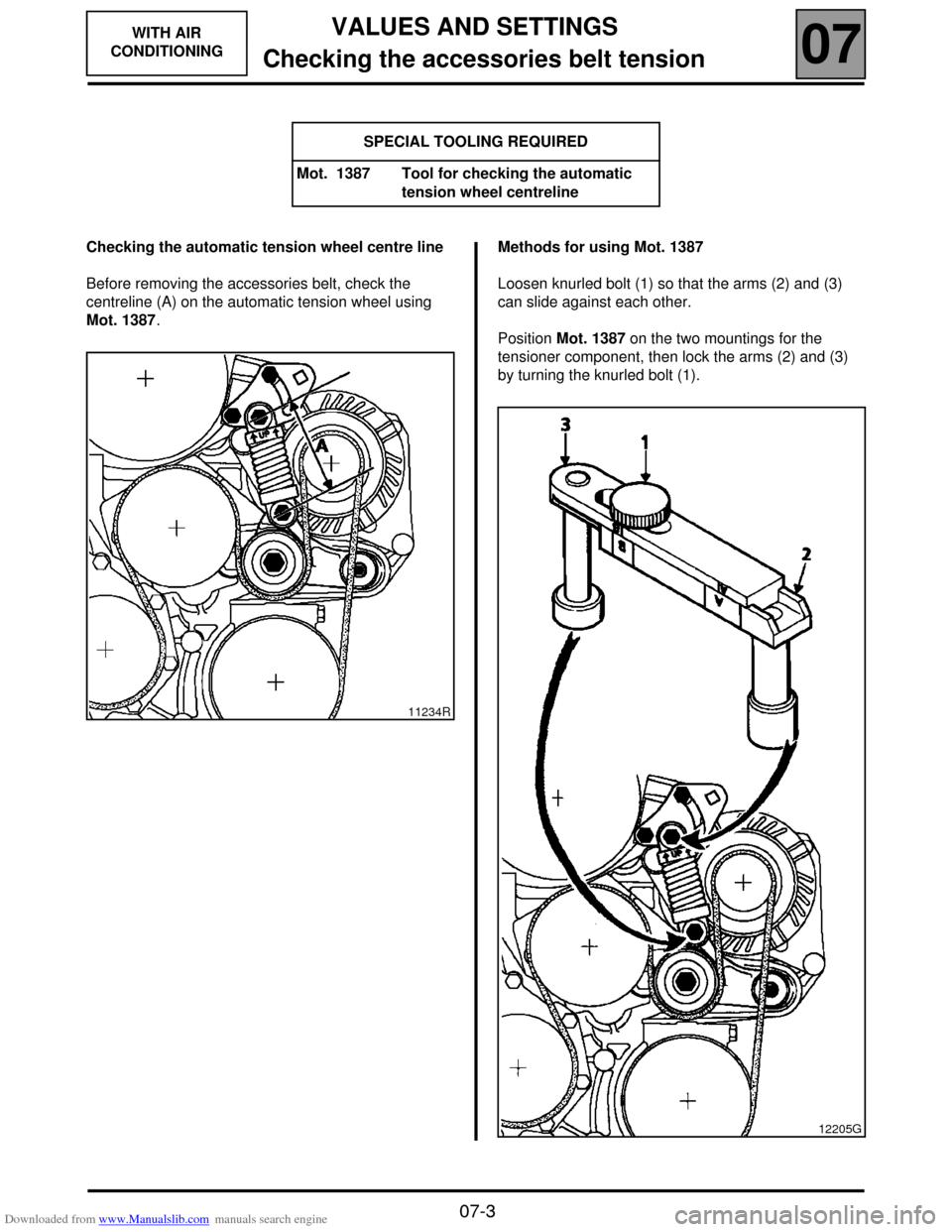
Downloaded from www.Manualslib.com manuals search engine VALUES AND SETTINGS
Checking the accessories belt tension
07
07-3
WITH AIR
CONDITIONING
Checking the accessories belt tension
SPECIAL TOOLING REQUIRED
Mot. 1387 Tool for checking the automatic
tension wheel centreline
Checking the automatic tension wheel centre line
Before removing the accessories belt, check the
centreline (A) on the automatic tension wheel using
Mot. 1387.Methods for using Mot. 1387
Loosen knurled bolt (1) so that the arms (2) and (3)
can slide against each other.
Position Mot. 1387 on the two mountings for the
tensioner component, then lock the arms (2) and (3)
by turning the knurled bolt (1).
11234R
12205G
Page 20 of 118
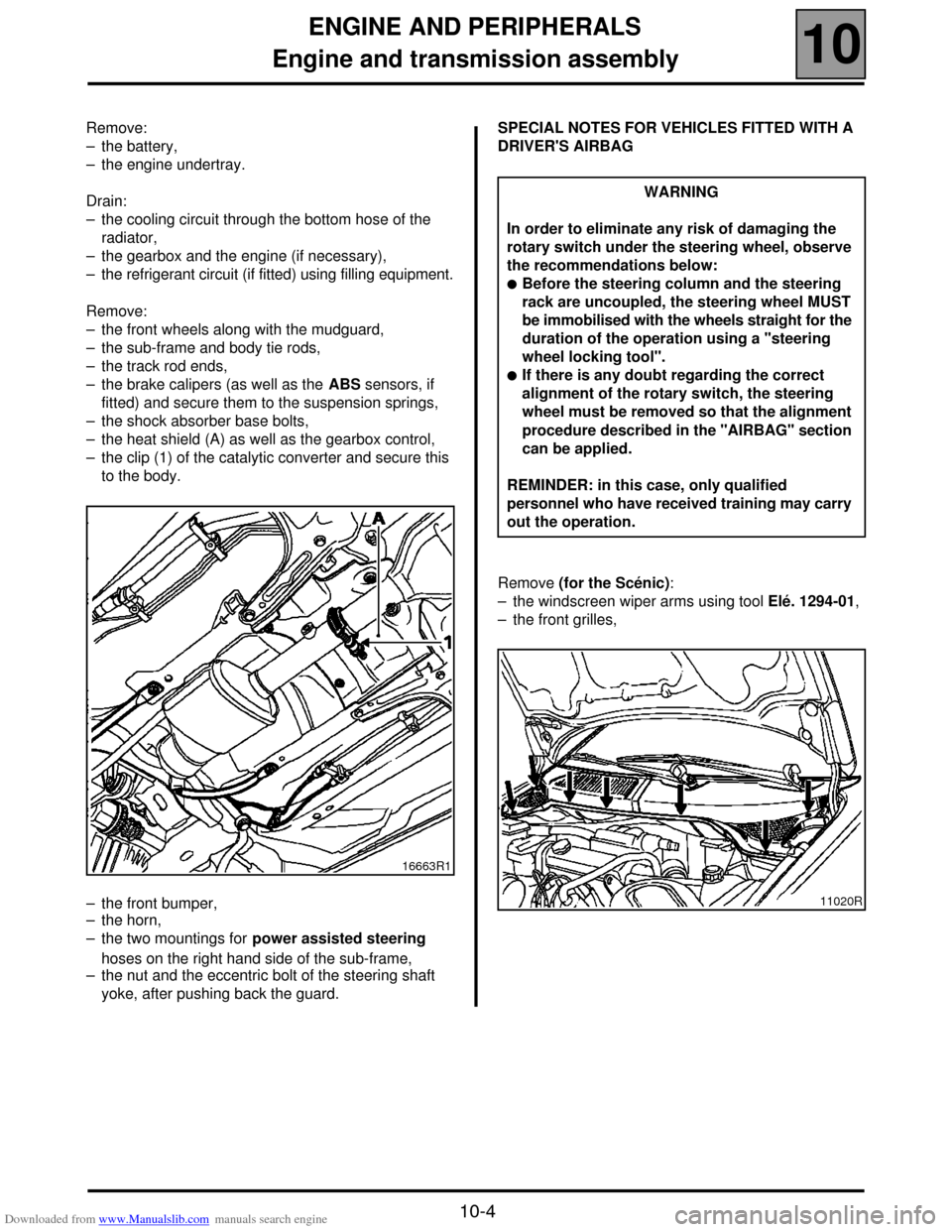
Downloaded from www.Manualslib.com manuals search engine ENGINE AND PERIPHERALS
Engine and transmission assembly
10
10-4
Remove:
– the battery,
– the engine undertray.
Drain:
– the cooling circuit through the bottom hose of the
radiator,
– the gearbox and the engine (if necessary),
– the refrigerant circuit (if fitted) using filling equipment.
Remove:
– the front wheels along with the mudguard,
– the sub-frame and body tie rods,
– the track rod ends,
– the brake calipers (as well as the ABS sensors, if
fitted) and secure them to the suspension springs,
– the shock absorber base bolts,
– the heat shield (A) as well as the gearbox control,
– the clip (1) of the catalytic converter and secure this
to the body.
– the front bumper,
– the horn,
– the two mountings for power assisted steering
hoses on the right hand side of the sub-frame,
– the nut and the eccentric bolt of the steering shaft
yoke, after pushing back the guard.SPECIAL NOTES FOR VEHICLES FITTED WITH A
DRIVER'S AIRBAG
Remove (for the Scénic):
– the windscreen wiper arms using tool Elé. 1294-01,
– the front grilles,
16663R1
WARNING
In order to eliminate any risk of damaging the
rotary switch under the steering wheel, observe
the recommendations below:
!Before the steering column and the steering
rack are uncoupled, the steering wheel MUST
be immobilised with the wheels straight for the
duration of the operation using a "steering
wheel locking tool".
!If there is any doubt regarding the correct
alignment of the rotary switch, the steering
wheel must be removed so that the alignment
procedure described in the "AIRBAG" section
can be applied.
REMINDER: in this case, only qualified
personnel who have received training may carry
out the operation.
11020R
Page 22 of 118
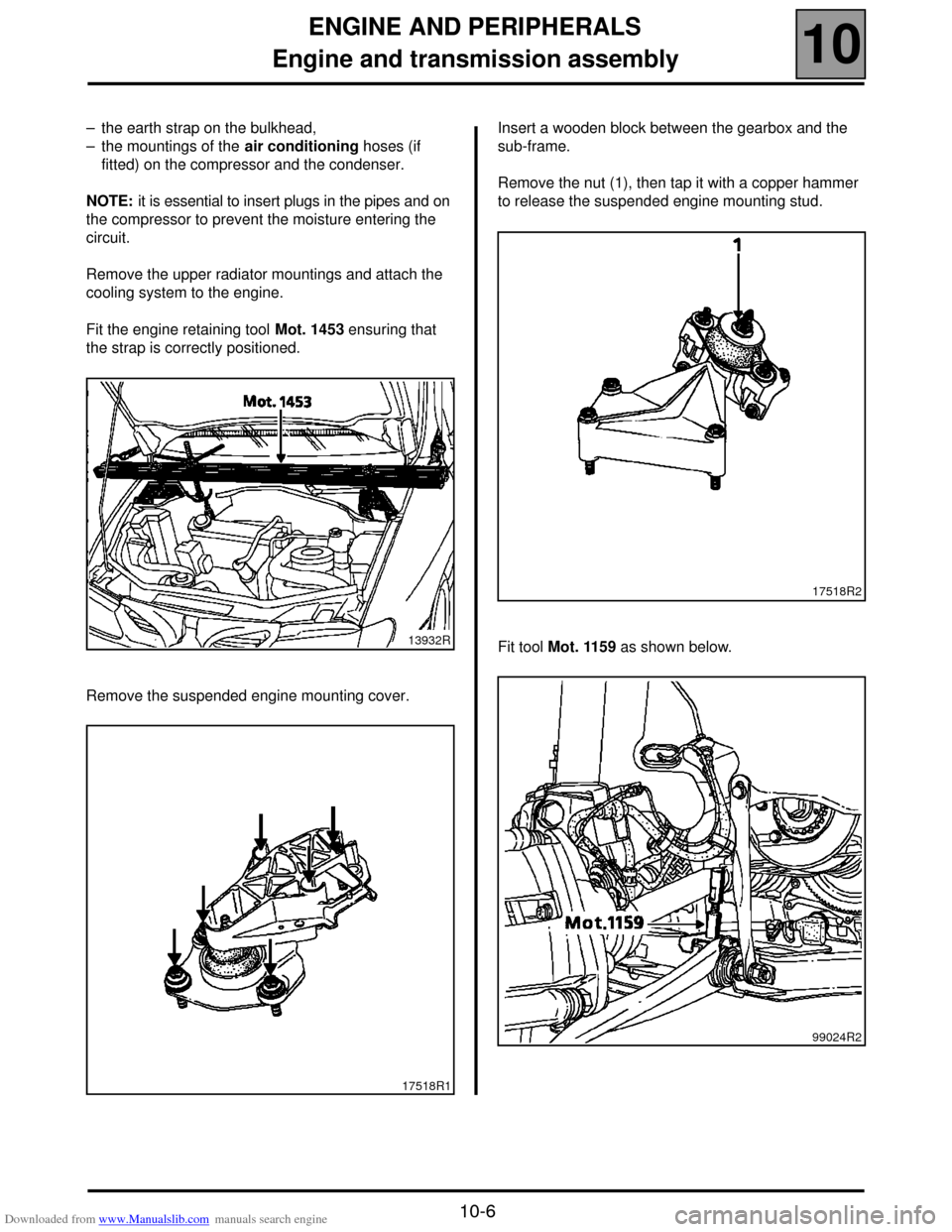
Downloaded from www.Manualslib.com manuals search engine ENGINE AND PERIPHERALS
Engine and transmission assembly
10
10-6
– the earth strap on the bulkhead,
– the mountings of the air conditioning hoses (if
fitted) on the compressor and the condenser.
NOTE: it is essential to insert plugs in the pipes and on
the compressor to prevent the moisture entering the
circuit.
Remove the upper radiator mountings and attach the
cooling system to the engine.
Fit the engine retaining tool Mot. 1453 ensuring that
the strap is correctly positioned.
Remove the suspended engine mounting cover.Insert a wooden block between the gearbox and the
sub-frame.
Remove the nut (1), then tap it with a copper hammer
to release the suspended engine mounting stud.
Fit tool Mot. 1159 as shown below.
13932R
17518R1
17518R2
99024R2
Page 24 of 118

Downloaded from www.Manualslib.com manuals search engine ENGINE AND PERIPHERALS
Sump
10
10-8
Sump
SPECIAL TOOLING REQUIRED
Mot. 1233-01 Threaded rods for lowering the
sub-frame
REMOVAL
Put the vehicle on a two post lift.
Disconnect the battery.
Remove the engine undertray.
Drain the engine.
Remove:
– the front wheels as well as the right hand mudguard
and the lower clip of the left hand mudguard,
– the nut and the eccentric bolt of the steering shaft
yoke, after pushing back the guard.Remove:
– the lower ball joint mountings as well as the track rod
ends,
– the sub-frame and body tie rods,
– the gear control on the gearbox side,
– the horn,
– the bolt (1), and slacken engine tie-bar bolt (2),
without removing it,
– the bottom mountings of the bumper, TIGHTENING TORQUES (n daN.m)
Sub-frame front mounting bolts 6.2
Sub-frame rear mounting bolts 10.5
Sump bolts 1.5
Steering shaft yoke mounting bolt 3
Lower ball joint mounting bolt 6
Engine tie bar bolt 6.2
Sub-frame - side member tie rod bolts 3
Wheel bolts 9
WARNING
In order to eliminate any risk of damaging the
rotary switch under the steering wheel, observe
the recommendations below:
!Before the steering column and the steering
rack are uncoupled, the steering wheel MUST
be immobilised with the wheels straight for the
duration of the operation using a "steering
wheel locking tool".
!If there is any doubt regarding the correct
alignment of the rotary switch, the steering
wheel must be removed so that the alignment
procedure described in the "AIRBAG" section
can be applied.
REMINDER: in this case, only qualified
personnel who have received training may carry
out the operation.
17518R3
Page 26 of 118
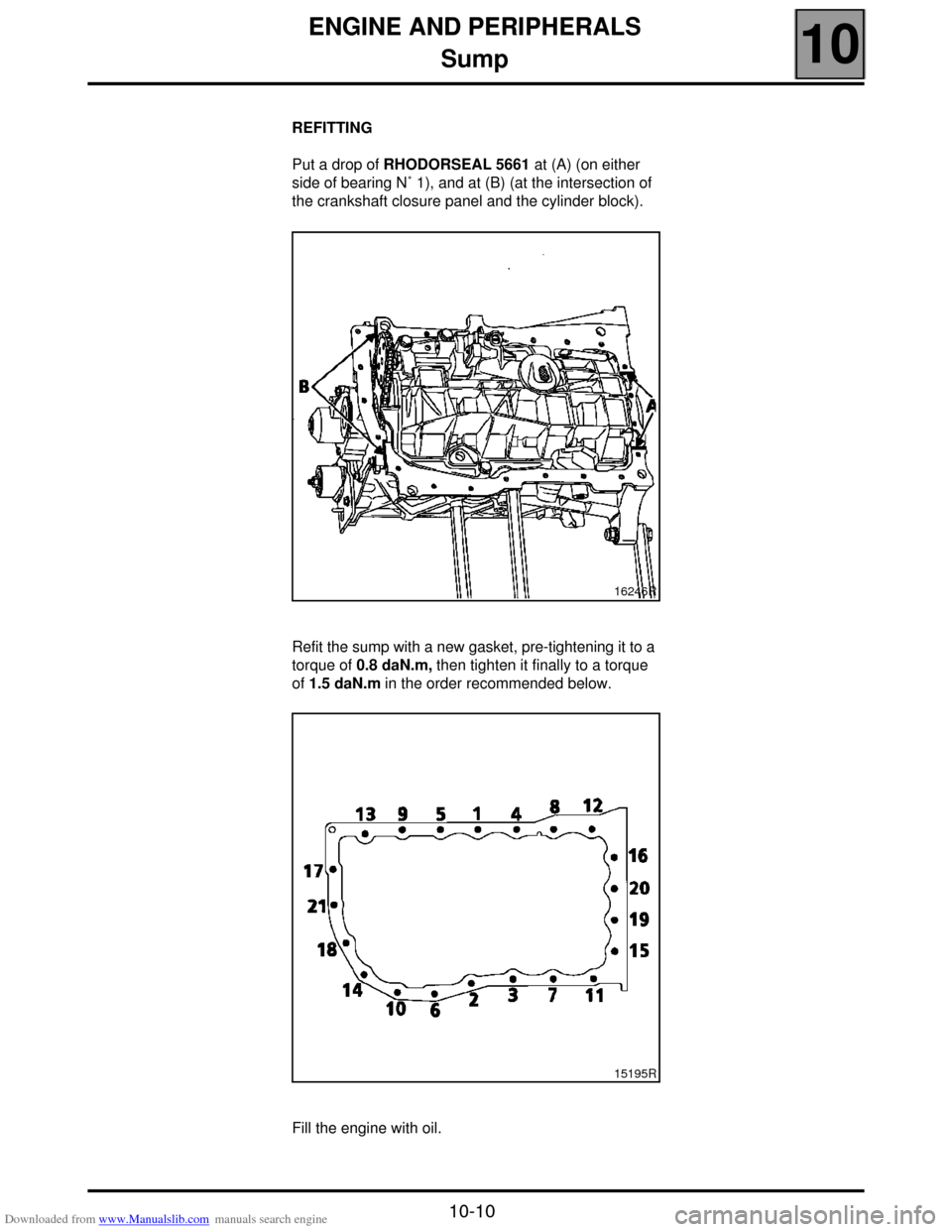
Downloaded from www.Manualslib.com manuals search engine ENGINE AND PERIPHERALS
Sump
10
10-10
REFITTING
Put a drop of RHODORSEAL 5661 at (A) (on either
side of bearing N˚ 1), and at (B) (at the intersection of
the crankshaft closure panel and the cylinder block).
Refit the sump with a new gasket, pre-tightening it to a
torque of 0.8 daN.m, then tighten it finally to a torque
of 1.5 daN.m in the order recommended below.
Fill the engine with oil.
16246R
15195R
Page 33 of 118
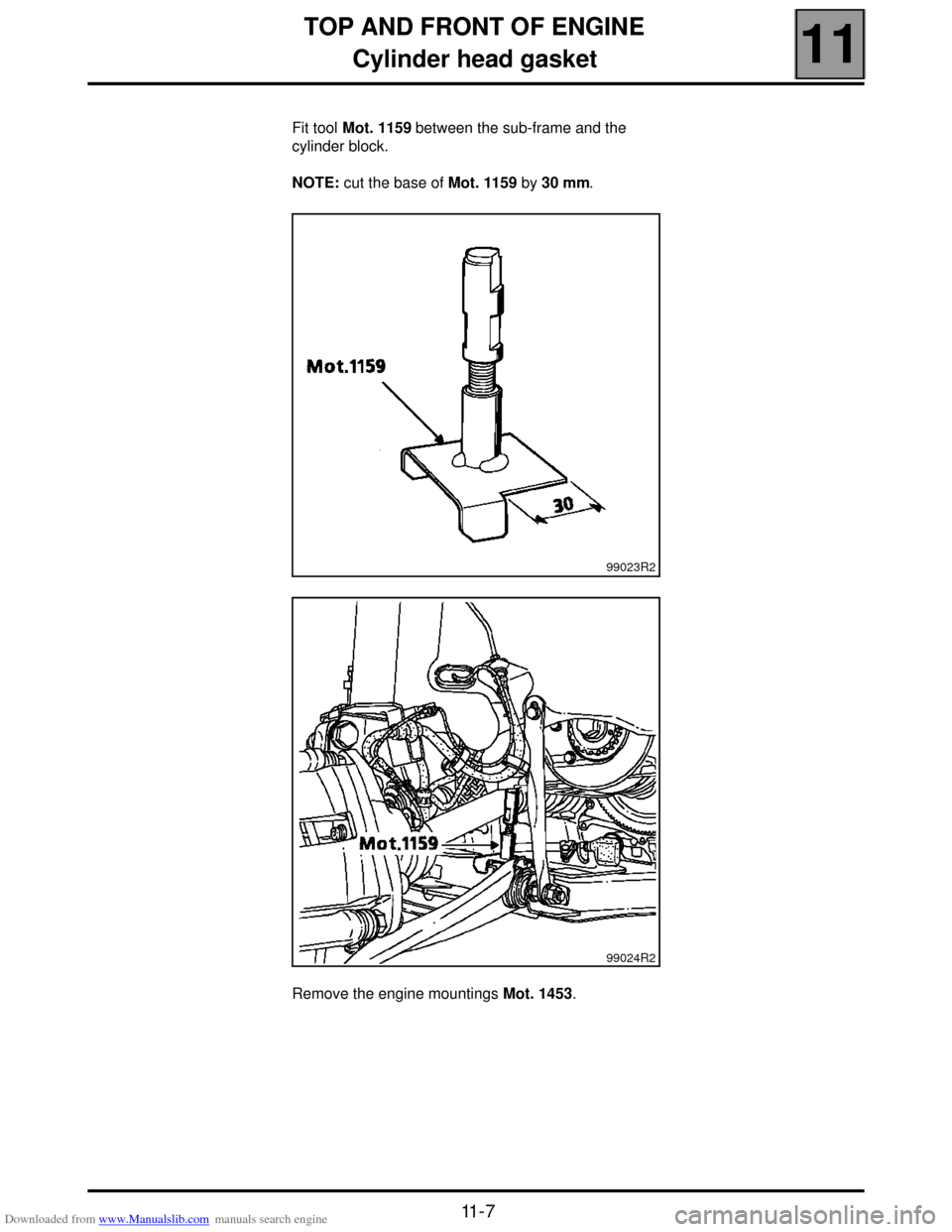
Downloaded from www.Manualslib.com manuals search engine TOP AND FRONT OF ENGINE
Cylinder head gasket
11
11 - 7
Fit tool Mot. 1159 between the sub-frame and the
cylinder block.
NOTE: cut the base of Mot. 1159 by 30 mm.
Remove the engine mountings Mot. 1453.
99023R2
99024R2
Page 37 of 118
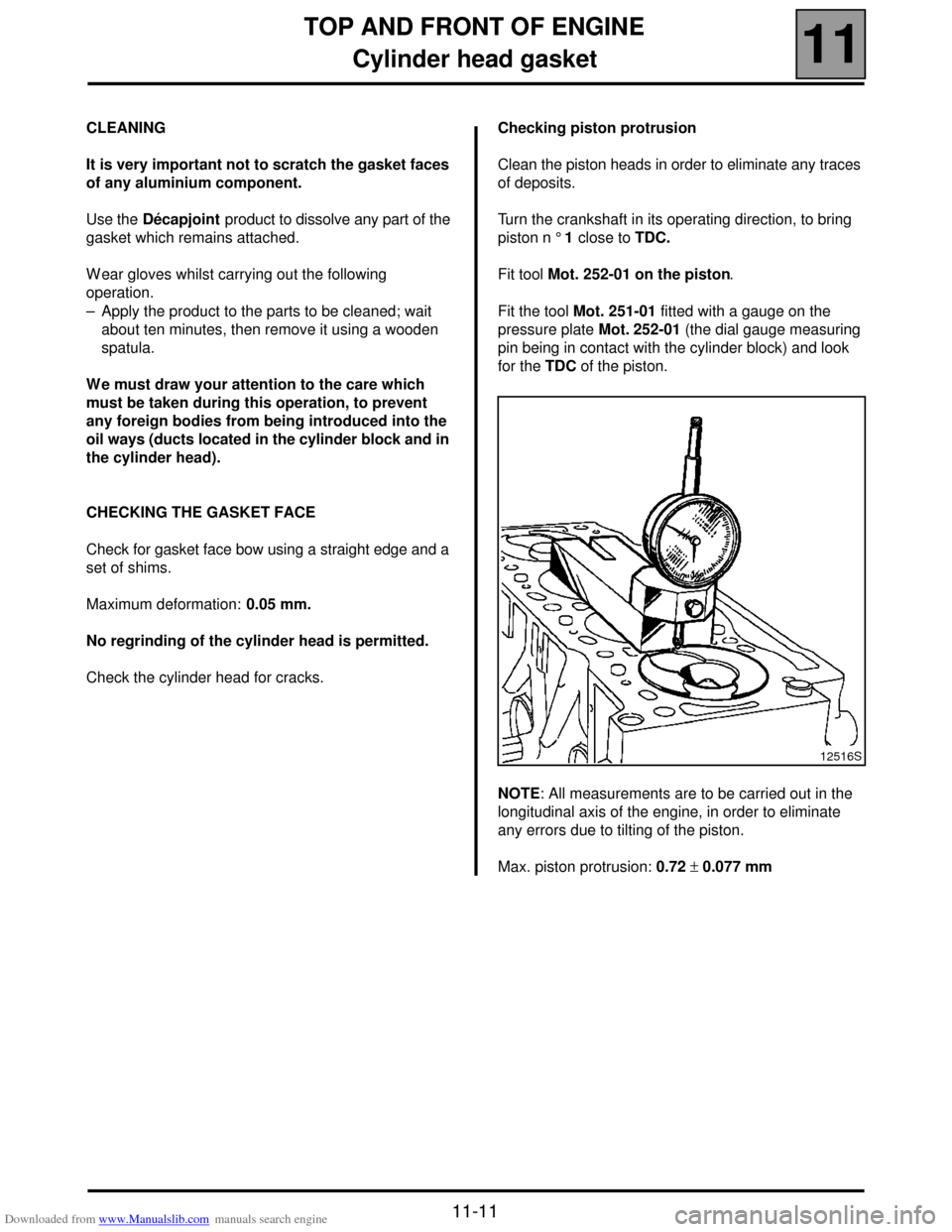
Downloaded from www.Manualslib.com manuals search engine TOP AND FRONT OF ENGINE
Cylinder head gasket
11
11-11
CLEANING
It is very important not to scratch the gasket faces
of any aluminium component.
Use the Décapjoint product to dissolve any part of the
gasket which remains attached.
W ear gloves whilst carrying out the following
operation.
– Apply the product to the parts to be cleaned; wait
about ten minutes, then remove it using a wooden
spatula.
W e must draw your attention to the care which
must be taken during this operation, to prevent
any foreign bodies from being introduced into the
oil ways (ducts located in the cylinder block and in
the cylinder head).
CHECKING THE GASKET FACE
Check for gasket face bow using a straight edge and a
set of shims.
Maximum deformation: 0.05 mm.
No regrinding of the cylinder head is permitted.
Check the cylinder head for cracks.Checking piston protrusion
Clean the piston heads in order to eliminate any traces
of deposits.
Turn the crankshaft in its operating direction, to bring
piston n ° 1 close to TDC.
Fit tool Mot. 252-01 on the piston.
Fit the tool Mot. 251-01 fitted with a gauge on the
pressure plate Mot. 252-01 (the dial gauge measuring
pin being in contact with the cylinder block) and look
for the TDC of the piston.
NOTE: All measurements are to be carried out in the
longitudinal axis of the engine, in order to eliminate
any errors due to tilting of the piston.
Max. piston protrusion: 0.72 ± 0.077 mm
12516S
Page 41 of 118
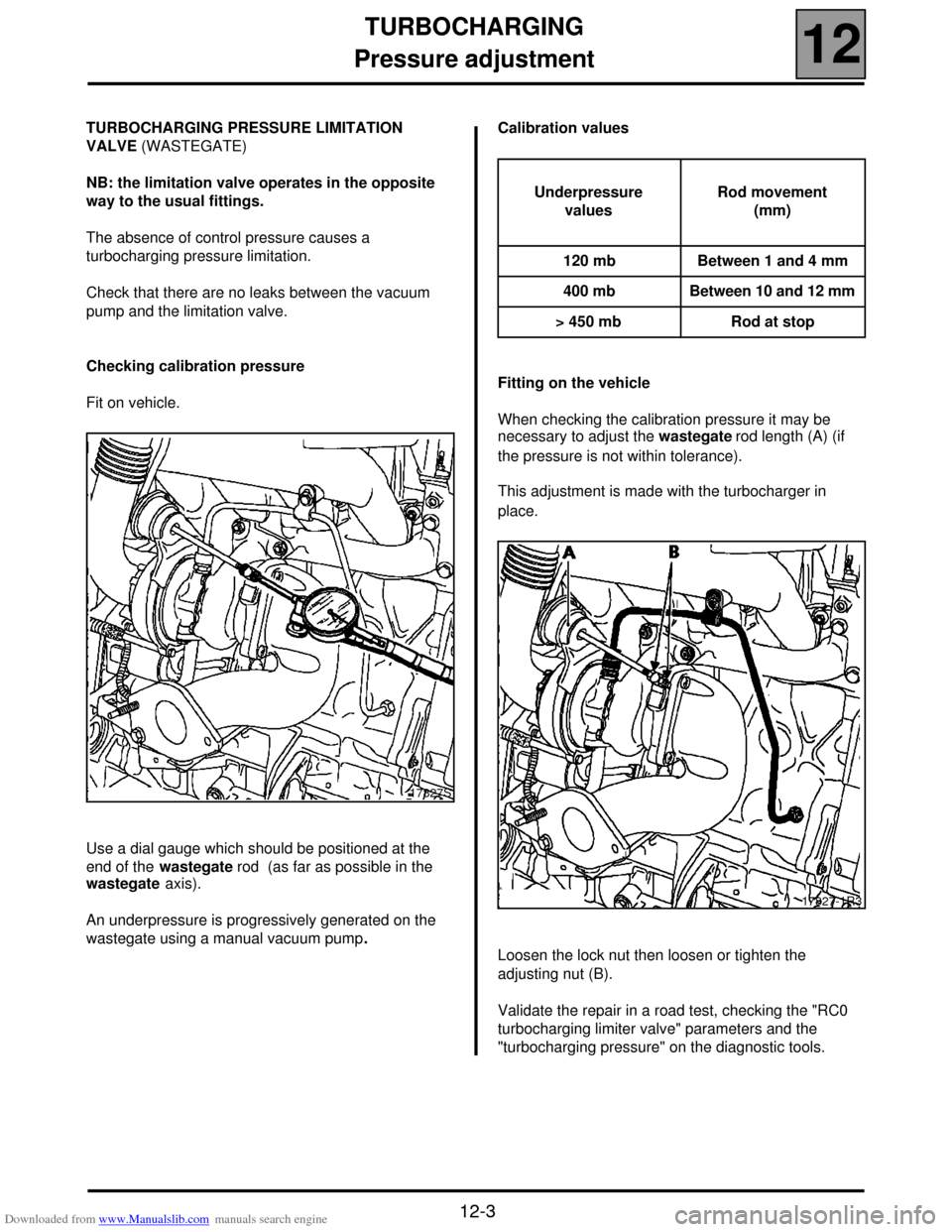
Downloaded from www.Manualslib.com manuals search engine TURBOCHARGING
Pressure adjustment
12
12-3
Pressure adjustment
TURBOCHARGING PRESSURE LIMITATION
VALVE (WASTEGATE)
NB: the limitation valve operates in the opposite
way to the usual fittings.
The absence of control pressure causes a
turbocharging pressure limitation.
Check that there are no leaks between the vacuum
pump and the limitation valve.
Checking calibration pressure
Fit on vehicle.
Use a dial gauge which should be positioned at the
end of the wastegate rod (as far as possible in the
wastegate axis).
An underpressure is progressively generated on the
wastegate using a manual vacuum pump.Calibration values
Fitting on the vehicle
When checking the calibration pressure it may be
necessary to adjust the wastegate rod length (A) (if
the pressure is not within tolerance).
This adjustment is made with the turbocharger in
place.
Loosen the lock nut then loosen or tighten the
adjusting nut (B).
Validate the repair in a road test, checking the "RC0
turbocharging limiter valve" parameters and the
"turbocharging pressure" on the diagnostic tools.
17827S
Underpressure
valuesRod movement
(mm)
120 mb Between 1 and 4 mm
400 mb Between 10 and 12 mm
> 450 mb Rod at stop
17827-1R3
Page 44 of 118
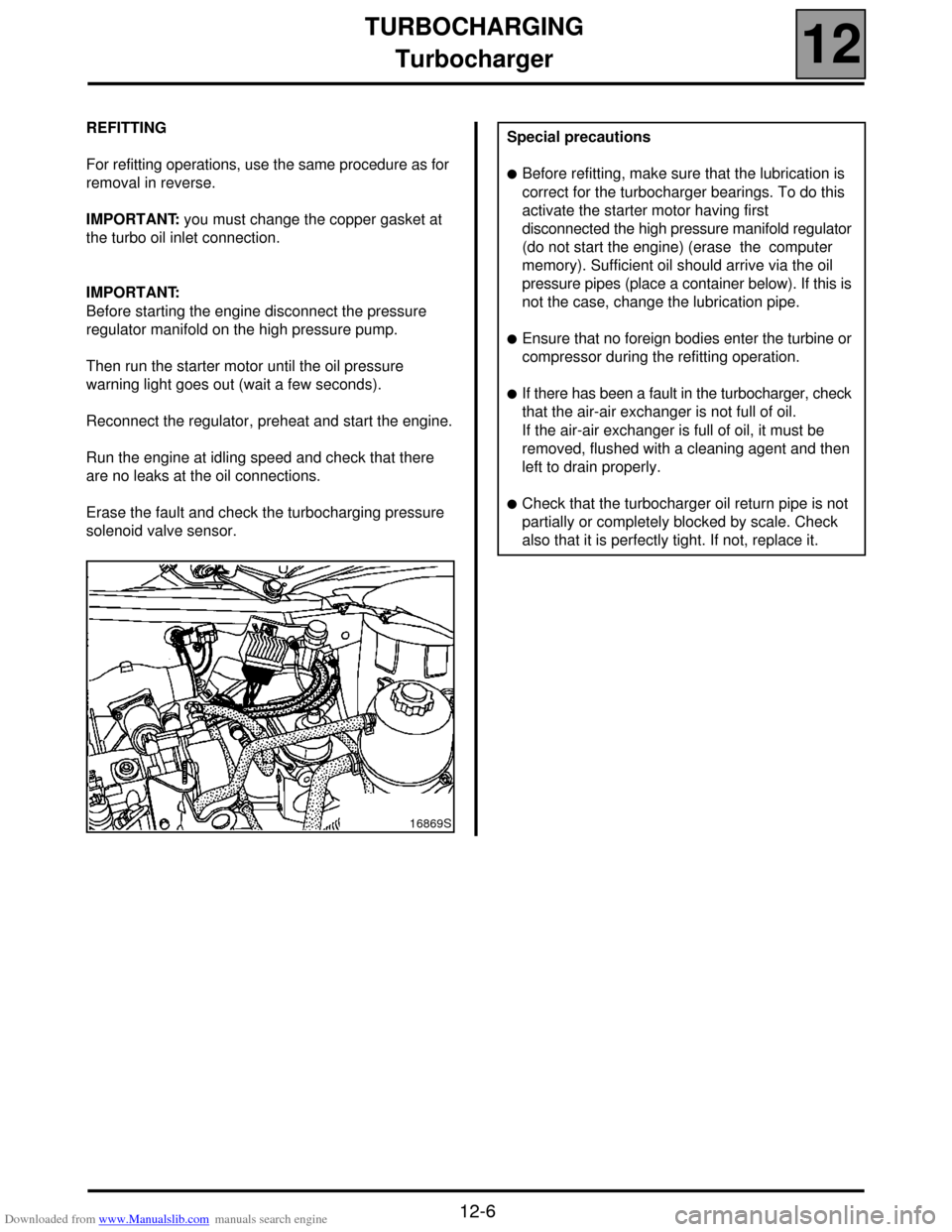
Downloaded from www.Manualslib.com manuals search engine TURBOCHARGING
Turbocharger
12
12-6
REFITTING
For refitting operations, use the same procedure as for
removal in reverse.
IMPORTANT: you must change the copper gasket at
the turbo oil inlet connection.
IMPORTANT:
Before starting the engine disconnect the pressure
regulator manifold on the high pressure pump.
Then run the starter motor until the oil pressure
warning light goes out (wait a few seconds).
Reconnect the regulator, preheat and start the engine.
Run the engine at idling speed and check that there
are no leaks at the oil connections.
Erase the fault and check the turbocharging pressure
solenoid valve sensor.
16869S
Special precautions
!Before refitting, make sure that the lubrication is
correct for the turbocharger bearings. To do this
activate the starter motor having first
disconnected the high pressure manifold regulator
(do not start the engine) (erase the computer
memory). Sufficient oil should arrive via the oil
pressure pipes (place a container below). If this is
not the case, change the lubrication pipe.
!Ensure that no foreign bodies enter the turbine or
compressor during the refitting operation.
!If there has been a fault in the turbocharger, check
that the air-air exchanger is not full of oil.
If the air-air exchanger is full of oil, it must be
removed, flushed with a cleaning agent and then
left to drain properly.
!Check that the turbocharger oil return pipe is not
partially or completely blocked by scale. Check
also that it is perfectly tight. If not, replace it.
Page 90 of 118
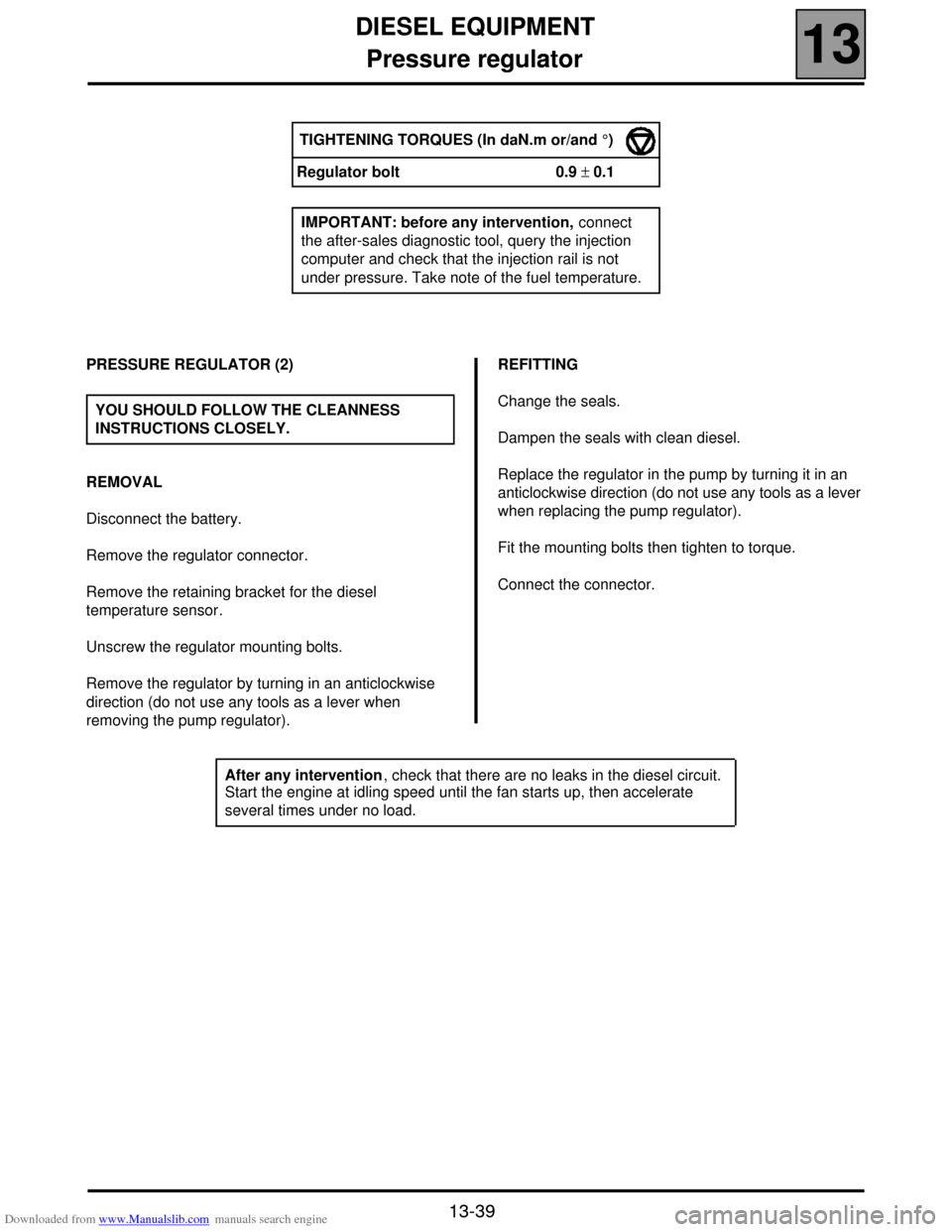
Downloaded from www.Manualslib.com manuals search engine DIESEL EQUIPMENT
Pressure regulator
13
13-39
Pressure regulator
TIGHTENING TORQUES (In daN.m or/and °)
Regulator bolt 0.9 ± 0.1
IMPORTANT: before any intervention, connect
the after-sales diagnostic tool, query the injection
computer and check that the injection rail is not
under pressure. Take note of the fuel temperature.
PRESSURE REGULATOR (2)
REMOVAL
Disconnect the battery.
Remove the regulator connector.
Remove the retaining bracket for the diesel
temperature sensor.
Unscrew the regulator mounting bolts.
Remove the regulator by turning in an anticlockwise
direction (do not use any tools as a lever when
removing the pump regulator).REFITTING
Change the seals.
Dampen the seals with clean diesel.
Replace the regulator in the pump by turning it in an
anticlockwise direction (do not use any tools as a lever
when replacing the pump regulator).
Fit the mounting bolts then tighten to torque.
Connect the connector. YOU SHOULD FOLLOW THE CLEANNESS
INSTRUCTIONS CLOSELY.
After any intervention, check that there are no leaks in the diesel circuit.
Start the engine at idling speed until the fan starts up, then accelerate
several times under no load.